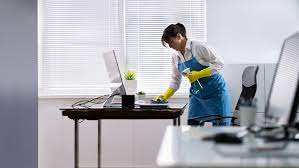Office cleaning is more than a quick tidy-up before guests arrive. It’s a structured process that keeps workspaces healthy, functional, and professional. From daily wipe-downs to scheduled deep cleans, Office Cleaning covers a wide range of tasks—each designed to support productivity, hygiene, and workplace safety.
But what type of cleaning does it actually involve? And why is it so essential for modern businesses? Let’s break down the core components, what to expect from professional cleaning services, and how it all impacts staff and visitors alike.
The Definition of Office Cleaning
Office Cleaning refers to the regular cleaning, sanitising, and maintenance of commercial workspaces. It includes everything from vacuuming and bin removal to disinfecting high-touch surfaces and managing shared areas like kitchens and bathrooms.
It’s typically delivered on a structured schedule—daily, weekly, monthly—by in-house teams or external cleaning contractors. It can happen during business hours or after hours, depending on what suits the workplace best.
The purpose? To create a clean, safe and pleasant environment that helps staff focus, keeps illness at bay, and leaves a good impression on clients and partners.
Types of Cleaning Tasks in a Standard Office
Professional office cleaning is usually split into three categories: daily, periodic, and deep cleaning.
✅ Daily Office Cleaning
These tasks are essential for keeping hygiene and presentation at a basic acceptable level.
- Empty rubbish and recycling bins
- Vacuum carpets and mop hard floors
- Disinfect desks, door handles, and shared equipment
- Wipe kitchen benches, taps, and appliances
- Clean and sanitise toilets and restock supplies
This daily maintenance helps prevent germs from spreading, controls odours, and maintains a level of cleanliness that supports staff wellbeing.
✅ Weekly or Fortnightly Cleaning
These services go a little deeper and handle areas that don’t need attention every single day:
- Wipe skirting boards and internal windows
- Clean inside microwaves, fridges and other appliances
- Dust air vents and less-accessible surfaces
- Polish glass doors and signage
- Remove built-up grime in kitchens and bathrooms
When these tasks are done regularly, they prevent bigger issues like staining, pest infestations, or unpleasant odours.
✅ Deep Cleaning (Monthly or Seasonal)
This is where heavy-duty cleaning tools and techniques are used:
- Carpet steam cleaning
- Stripping and sealing vinyl flooring
- Detailed bathroom sanitisation
- Upholstery and fabric chair cleaning
- High dusting (lights, ducts, ceilings)
Deep cleans help maintain the condition of office fixtures and fittings over the long term, reducing replacement and maintenance costs.
For full-service Office Cleaning, businesses often combine all three approaches in a tailored schedule that fits their workflow and foot traffic.
Common Zones Targeted in Office Cleaning
Each office is different, but professional cleaners typically focus on the following spaces:
- Workstations and desks: Sanitising surfaces, clearing bins, and cleaning under monitors.
- Meeting rooms: Wiping tables, tech equipment, and chairs; restocking supplies.
- Reception areas: Keeping entryways dust-free, floors clean, and signage polished.
- Kitchens: Wiping benches, emptying bins, cleaning fridges and microwaves.
- Bathrooms: Sanitising toilets, floors, sinks, and replenishing soap and paper.
- High-traffic touchpoints: Door handles, lift buttons, railings, phones, and shared desks.
A well-maintained Office Cleaning checklist makes sure these zones are cleaned systematically and consistently.
What Makes Office Cleaning Different from Domestic Cleaning?
While both types aim to maintain cleanliness and hygiene, the environments—and requirements—are very different.
Here’s how office cleaning stands apart:
| Feature | Office Cleaning | Domestic Cleaning |
|---|---|---|
| Scale & Frequency | Larger spaces, daily or weekly | Smaller areas, usually weekly or fortnightly |
| Cleaning Timeframes | After hours or early morning | More flexible |
| Compliance & Standards | WHS compliance, public hygiene standards | Minimal regulatory requirements |
| Equipment Used | Commercial vacuums, mops, sanitisers | Basic household cleaning products |
| Scope | Includes tech equipment and shared zones | Focused on personal living spaces |
Professional office cleaners are trained to handle commercial environments with efficiency and discretion—especially in areas like data-sensitive offices, high-rise buildings, and shared workplaces.
Cleaning for Health and Productivity
Office cleaning is about more than hygiene—it’s about creating a productive work environment. A cluttered, dusty or smelly office can reduce staff focus and motivation.
Studies show that tidy spaces help with concentration and reduce mental fatigue. On the flip side, offices that ignore cleaning often suffer from more sick days, higher staff turnover, and negative client feedback.
According to Safe Work Australia, employers must provide workplaces that are clean and hygienic to meet health and safety standards—especially in environments where illness can easily spread through shared touchpoints.
Regular cleaning is a low-cost way to support better mental health, reduce absenteeism, and make the office somewhere people actually want to be.
A Real Example: Cleaned Up, Leveled Up
A logistics company in Melbourne used to clean their office once a week. Desks were dusty. Kitchen smells lingered. The bathrooms were a common complaint.
After engaging a professional cleaning team for daily services and quarterly deep cleans, the difference was obvious:
- Staff sick leave reduced by 18% over six months
- Client visitors increased, with more in-person meetings booked
- Office satisfaction scores rose in HR pulse surveys
The team didn’t hire more staff or change locations—they simply prioritised a consistent Office Cleaning program. The payoff was higher productivity and better team morale.
Final Word: Clean Offices Work Better
So what type of cleaning is office cleaning? It’s structured, scheduled, and strategic. It’s the daily work that keeps businesses running smoothly—without anyone needing to think about it.
From wiping desks to steam-cleaning carpets, office cleaning supports the health, image, and performance of your organisation. Whether it’s five desks or five floors, the result is the same: a clean space where people feel ready to work.
If your cleaning setup feels ad hoc, it might be time to reset. Start with a conversation about professional Office Cleaning—and let your workplace shine every day.

